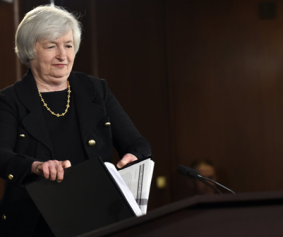Fed – No Interest Rate Hike Anytime Soon
Saturday, September 20th, 2014 @ 6:47PM
Gary D. Halbert
Between the Lines
The Fed’s latest two-day policy meeting that adjourned yesterday was perhaps the most anticipated of the year. Why? Most Fed-watchers believed that the Fed Open Market Committee (FOMC) might drop a hint in its official policy statement about when it will enact the first interest rate hike next year – what the Fed refers to as “liftoff.”
Ahead of this week’s FOMC meeting, the thinking in financial circles was that the Fed might change some language in yesterday’s policy statement which would suggest that the first rate hike will come sooner rather than later. Specifically, Fed-watchers thought the FOMC would amend the following passage which has appeared in FOMC statements earlier this year:
The Committee continues to anticipate, based on its assessment of these factors,
that it likely will be appropriate to maintain the current target range for the
federal funds rate for a considerable time after the asset purchase program ends.
[Emphasis mine.]
The consensus was that the Fed might omit the words “considerable time” from yesterday’s policy statement. So, did it happen (drumroll please)? NO. The sentence highlighted just above remained in yesterday’s policy statement – to the letter. Given that there was no change in this “forward guidance,” it still looks like the Fed funds rate will remain near zero until around the middle of next year. As I wrote on Tuesday:
“… a chorus of financial writers seems to be convinced that she [Yellen]
wants to raise rates sooner. While no one can be sure, there is nothing to
suggest she is in a hurry.”
Elsewhere in the statement, the FOMC’s view of the economy was also little changed:
“Information received since the Federal Open Market Committee met in July suggests that economic activity is expanding at a moderate pace. On balance, labor market conditions improved somewhat further; however, the unemployment rate is little changed and a range of labor market indicators suggests that there remains significant underutilization of labor resources. Household spending appears to be rising moderately and business fixed investment is advancing, while the recovery in the housing sector remains slow.” [Emphasis mine]
Chair Yellen has acknowledged that she wants to see labor utilization improve before raising rates, and with the much weaker than expected jobs report for July, that’s just not happening. Some Fed-watchers had thought the FOMC might delete the continued reference to “underutilization” in yesterday’s statement; however, after the very disappointing employment report for July, this language stayed in, as it should have.
As expected, the Fed voted to reduce QE purchases by another $10 billion per month from $25 billion to $15 billion. Beginning in October, the Committee will add to its holdings of mortgage-backed securities at a pace of $5 billion per month, and will add to its holdings of longer-term Treasury securities at a pace of $10 billion per month.
This means that the FOMC is likely to vote to end QE at its next policy meeting on October 28-29 and purchases will likely be halted thereafter. This continues to suggest that the first interest rate hike probably won’t occur until the middle of next year.
In her press conference yesterday, Yellen once again stated that the timing of the first rate hike would depend on the economy. Specifically, if the economy grows stronger than expected, then the first rate hike would happen sooner; and if the economy is weaker, the rate hike would come later.
The FOMC also released a new document entitled “Policy Normalization Principles and Plans” which discusses how the Fed intends to normalize interest rates and how it plans to reduce its $4.4 trillion inventory of securities over time.
The FOMC revised its economic projections slightly to the downside of what was forecast at the June meeting. The forecast for GDP was revised as follows from the June projections:
| 2014 | 2015 | 2016 | 2017 |
| 2.1-2.3% June | 3.0-3.3% June | 2.5-3.0% June | n/a |
| 2.0-2.2% Sept | 2.6-3.0% Sept | 2.6-2.9% Sept | 2.3-2.5% Sept |
This is the second time this year that the FOMC downgraded its economic forecasts. This is the first time that the FOMC has offered an economic forecast for 2017. If their forecasts are anywhere near accurate, our snail’s-pace economic growth will continue for several more years.
Let’s hope they are wrong!
Posted by AIA Research & Editorial Staff
Categories: Between the Lines


